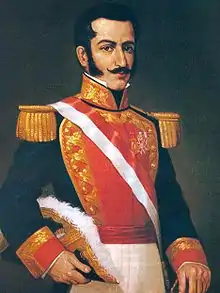Felipe Santiago Salaverry
Felipe Santiago de Salaverry (1805 in Lima, Peru – February 19, 1836 in Arequipa, Peru) was a Peruvian soldier and politician who served as the 13th President of Peru.
Felipe Santiago Salaverry | |
|---|---|
 | |
| Born | May 3, 1806 |
| Died | February 18, 1836 (aged 29) |
| Occupation | President |
| Predecessor | Manuel Salazar y Baquíjano |
| Successor | Luis José de Orbegoso |
| Spouse(s) | Juana Pérez Palza de Infantas |
| Children | Carlos Augusto Salaverry Ramírez Felipe Augusto Salaverry Pérez |
He studied in the College of San Carlos in Lima. When José de San Martín arrived in Peru in 1820, Salaverry left college despite his father's opposition, and made his way to Huaura Province, where he volunteered to join the general and his forces. San Martin enlisted Salaverry as a cadet of the battalion of Numancia, a campaign against the Spaniards. He led the Peruvian Cavalry at the battles of Junin and Ayacucho, helping secure the Independence of Peru and routing the Spanish Army. After the establishment of the republic of Peru, Salaverry rose rapidly in the army. At the age of twenty-eight, Salaverry obtained the rank of General Inspector of the Peruvian Army.
When the garrison of Callao revolted in January 1835, against then President Luis Orbegoso, and pronounced in favor of La Fuente, Salaverry defeated the insurgents. Orbegoso appointed him governor of the fortress. But on February 23, Salaverry rose in arms against the government. After Orbegoso abandoned Lima, Salaverry occupied the capital and proclaimed himself "Supreme Chief of the Republic" on 25 February. In a few months he had possession of the south, and Orbegoso retreated with a small force to the northern provinces.
A decree of Felipe Santiago Salaverry re-legalizes the importation of slaves from other Latin American countries. The line "no slave shall enter Peru without becoming free" is taken out of the Constitution in 1839.[1]
He sought the intervention of Andrés Santa Cruz, leader of Bolivia, with whom Orbegoso concluded a treaty giving Santa Cruz a third of Peru. Soon after, the Bolivian army invaded Peru, and Salaverry retreated to the city of Arequipa. Salaverry obtained victories at the battle of Uchumayo, February 4, 1836, but on February 7, his forces were totally routed in Socabaya, a district of the city.
After wandering for several days in his way to join the Peruvian Navy stationed at the coast at Islay in Arequipa, Salaverry trusted the General Miller who was persecuting him, who delivered him to Santa Cruz. Contrary to the customs of war against enemies who surrender, Santa Cruz ordered the execution of Salaverry and his General Staff, they assaulted him at The Plaza Major of Arequipa being assassinated, he survived since the Bolivian soldiers were very respectful of this brave General who refuse to covered his eyes and who was severely injured with a bloody leg, the unjust Santa Cruz ordered to shoot him again against the rules of civility, Salaverry was only thirty years old. This led to popular resistance and ultimately defeat of the Peru–Bolivian Confederation led by Santa Cruz, who escape to Chile and then to France. Salaverry's field jacket was given to his crying widow full of bullet holes, which is shown at the Peruvian Museum of Gold at Monterrico.
See also
- List of Presidents of Peru
References
- Código Civil de 1852: Lo nacional y lo importado, by César Luna Victoria León.
Further reading
- Bilbao, Manuel. Historia del General Salaverry. 3rd ed. (1936)
- Pike, Frederick B. The Modern History of Peru (1967)
- Walker, Charles F. "Felipe Santiago Salaverry" in Encyclopedia of Latin American History and Culture, vol. 5, p. 15. New York: Charles Scribner's Sons 1996.
| Political offices | ||
|---|---|---|
| Preceded by Luis José de Orbegoso y Moncada |
President of Peru 1835–1836 |
Succeeded by Andrés de Santa Cruz |
